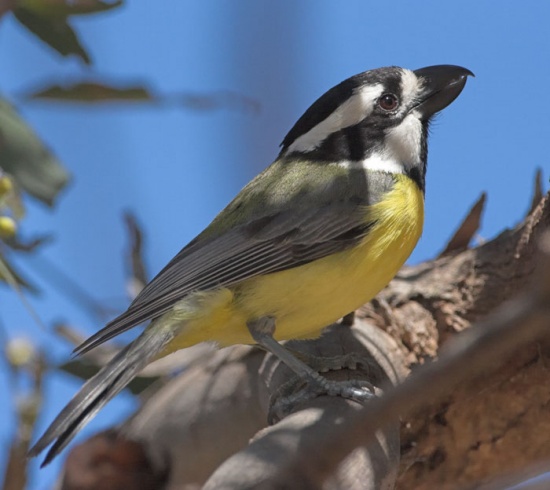m (taxonomy, move information on the other two species in this complex) |
(GS) |
||
| (19 intermediate revisions by 4 users not shown) | |||
| Line 1: | Line 1: | ||
| − | + | [[Image:Eastern_or_Crested_Shrike_Tit.jpg|thumb|550px|right|Photo by {{user|rebelxt|rebelxt}}<br />Adelaide, [[Australia]], November 2005]] | |
| − | + | '''Alternative names: Eastern Shriketit, Eastern Shrike Tit''' | |
| − | [[Image:Eastern_or_Crested_Shrike_Tit.jpg|thumb|550px|right|Photo by rebelxt | + | ;[[:Category:Falcunculus|Falcunculus]] frontatus |
==Identification== | ==Identification== | ||
| + | [[Image:Crested-Shrike-Tit-fem-A8943W.jpg|thumb|350px|right|Female, notice the green throat<br />Photo by '''[http://www.birdforum.net/member.php?u=49168 Hans&Judy Beste]'''<br />Toowoomba Shire, [[Queensland]], April 2018]] | ||
| + | 16–19 cm (6¼-7½ in) | ||
| + | *Dull green back and wings | ||
| + | *Yellow belly | ||
| + | *Boldly marked black and white head | ||
| + | *Small black crest. | ||
| + | *Bill is unusually deep, strong and hooked | ||
| + | Females are similar to males but have a dark olive-green throat. | ||
| + | ====Similar Species==== | ||
| + | [[Western Shrike-tit]] has a white belly while [[Northern Shrike-tit]] is smaller and paler.<br /> | ||
| + | |||
==Distribution== | ==Distribution== | ||
| − | + | Eastern and southern [[Australia]]: from central [[Queensland]] to southern [[Victoria]] and southeast [[South Australia]]) | |
| + | |||
==Taxonomy== | ==Taxonomy== | ||
| + | This is a [[Dictionary_M-O#M|monotypic]] species<sup>[[#References|[1]]]</sup>. | ||
| − | + | This species was formerly included in Crested Shrike-tit together with [[Western Shrike-tit]] and [[Northern Shrike-tit]]. | |
==Habitat== | ==Habitat== | ||
| + | Eucalyptus forests and woodlands. Also in riparian vegetation or mature rainforest in some areas. | ||
==Behaviour== | ==Behaviour== | ||
| + | Resident with some local movements. | ||
| + | ====Diet==== | ||
| + | Feeds mainly on insects, takes also spiders, fruit seeds and arils. Forages in trees, taking prey from barks or foliage. | ||
| + | ====Breeding==== | ||
| + | |||
| + | Breeding season from August to January, usually double-brooded. The nest is a deep cup, made by the female with bark strips and dry grass. It's placed 6 - 15m high in a tree fork. Lays 2 - 3 eggs.<br /> | ||
| + | Nests parasitized by [[Pallid Cuckoo]], [[Brush Cuckoo]] and [[Fan-tailed Cuckoo]]. | ||
| + | |||
| + | ====Vocalisation==== | ||
| + | A whistle which due to falling slightly in pitch can be described as mournful. This sound is usually given as part of a series with between 1 and 9 repeats, and the first couple of repeats usually less strong in volume. | ||
| + | ==References== | ||
| + | #{{Ref-Clements6thOct22}}#{{Ref-GillDonskerRasmussen22V13.1}}#Kirwan, G. M., W. Boles, and D. A. Christie (2022). Eastern Shrike-tit (Falcunculus frontatus), version 1.0. In Birds of the World (N. D. Sly, Editor). Cornell Lab of Ornithology, Ithaca, NY, USA. https://doi.org/10.2173/bow.cresht1.01 | ||
| + | {{ref}} | ||
==External Links== | ==External Links== | ||
| − | {{GSearch|Falcunculus | + | {{GSearch|"Falcunculus frontatus" {{!}} "Eastern Shrike-tit" {{!}} "Eastern Shriketit" {{!}} "Eastern Shrike Tit"}} |
| − | + | {{GS-checked}}1<br /><br /> | |
| − | [[Category:Birds]] | + | [[Category:Birds]] [[Category:Falcunculus]] |
Latest revision as of 23:37, 31 July 2023
Alternative names: Eastern Shriketit, Eastern Shrike Tit
- Falcunculus frontatus
Identification
16–19 cm (6¼-7½ in)
- Dull green back and wings
- Yellow belly
- Boldly marked black and white head
- Small black crest.
- Bill is unusually deep, strong and hooked
Females are similar to males but have a dark olive-green throat.
Similar Species
Western Shrike-tit has a white belly while Northern Shrike-tit is smaller and paler.
Distribution
Eastern and southern Australia: from central Queensland to southern Victoria and southeast South Australia)
Taxonomy
This is a monotypic species[1].
This species was formerly included in Crested Shrike-tit together with Western Shrike-tit and Northern Shrike-tit.
Habitat
Eucalyptus forests and woodlands. Also in riparian vegetation or mature rainforest in some areas.
Behaviour
Resident with some local movements.
Diet
Feeds mainly on insects, takes also spiders, fruit seeds and arils. Forages in trees, taking prey from barks or foliage.
Breeding
Breeding season from August to January, usually double-brooded. The nest is a deep cup, made by the female with bark strips and dry grass. It's placed 6 - 15m high in a tree fork. Lays 2 - 3 eggs.
Nests parasitized by Pallid Cuckoo, Brush Cuckoo and Fan-tailed Cuckoo.
Vocalisation
A whistle which due to falling slightly in pitch can be described as mournful. This sound is usually given as part of a series with between 1 and 9 repeats, and the first couple of repeats usually less strong in volume.
References
- Clements, J. F., T. S. Schulenberg, M. J. Iliff, T. A. Fredericks, J. A. Gerbracht, D. Lepage, S. M. Billerman, B. L. Sullivan, and C. L. Wood. 2022. The eBird/Clements checklist of Birds of the World: v2022. Downloaded from https://www.birds.cornell.edu/clementschecklist/download/
- Gill, F, D Donsker, and P Rasmussen (Eds). 2023. IOC World Bird List (v 13.1)_red. Doi 10.14344/IOC.ML.13.1. http://www.worldbirdnames.org/
- Kirwan, G. M., W. Boles, and D. A. Christie (2022). Eastern Shrike-tit (Falcunculus frontatus), version 1.0. In Birds of the World (N. D. Sly, Editor). Cornell Lab of Ornithology, Ithaca, NY, USA. https://doi.org/10.2173/bow.cresht1.01
Recommended Citation
- BirdForum Opus contributors. (2024) Eastern Shrike-tit. In: BirdForum, the forum for wild birds and birding. Retrieved 16 June 2024 from https://www.birdforum.net/opus/Eastern_Shrike-tit
External Links
GSearch checked for 2020 platform.1





